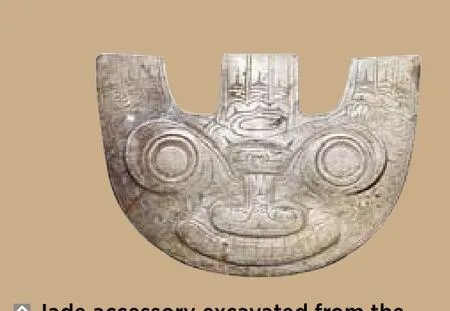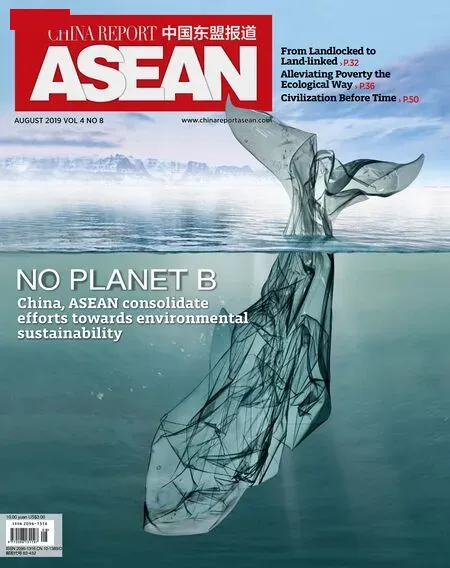CIVILIZATION BEFORE TIME Archaeological Ruins of Liangzhu City named a UNESCO World Heritage Site
By Wang Fengjuan
On July 16, 2019, an exhibition titled “Liangzhu and Ancient China—5,000 Years of Civilization Demonstrated by Jade” opened at the Palace Museum (Forbidden City) in Beijing. The exhibition showcased 260 jade artifacts that were excavated from the Archaeological Ruins of Liangzhu City in Hangzhou, capital of southeastern China's Zhejiang Province, and held by 17 museums in nine Chinese provinces and municipalities. It marked the first time the cultural relics were displayed after the Archaeological Ruins of Liangzhu City was added to the UNESCO World Heritage List at the 43rd session of the UNESCO World Heritage Committee in the Azerbaijani capital of Baku on July 7, 2019.
The exhibition used jade artifacts to trace 5,000 years of Chinese civilization from the Neolithic Liangzhu culture to the Ming (1368-1644) and Qing (1644-1911) dynasties, reflecting on the influence of the Neolithic regional state of Liangzhu on the cultures of later ages.

Jade accessory excavated from the Liangzhu relic site on display in the Zhejiang Provincial Museum.
Perhaps the two most important jade artifacts on display are a jade cylinder (cong, nicknamed the “King of Cong”) and a jade axe (yue, nicknamed the “King of Yue”). The jade cylinder with a quadrilateral exterior decorated with exquisite engraved representations of humans and animals was excavated from a tomb in Liangzhu City. In the Liangzhu culture, the jade cylinder was a ritual ware to communicate between heaven and earth, man and god. The jade axe was excavated from the same tomb. It is the only jade axe of its kind decorated with engraved representations of gods, humans, animals and birds. The luxurious instrument was a king's scepter meant to symbolize power and authority.
“The jade artifacts unearthed from the Ruins of Liangzhu City have obvious symbolic significance,” commented Colin Renfrew, a renowned British archaeologist and senior fellow at Cambridge University's McDonald Institute for Archaeological Research. “They symbolize the formation of a cultural entity with a common philosophy, which reflects to a great extent the complexity of the society and the class system at that time at a level equal to that of a ‘state'.”

Ritual jade disk excavated from the Liangzhu relic site on display in the Shanghai Museum.

Red pottery spouted drinking vessel excavated from the Liangzhu relic site.
Miyamoto Kazuo, professor at Japan's Kyushu University and an East Asian archaeologist, believes that Liangzhu jade artifacts are important to tracing not only the spread of the utensils, but also the spread of “a part of a lifestyle with a certain function.”
5,000-Year-Old Civilization
The Liangzhu culture was discovered in the Taihu Lake Basin in the lower reaches of the Yangtze River.
The Archaeological Ruins of Liangzhu City is located in Hangzhou and considered a cultural site of Neolithic China.
Five thousand years ago, a magnificent city was built on the site. Enormous changes have taken place over the last millennia. In 1936, Shi Xingeng, a researcher at Hangzhou's West Lake Museum, first discovered the site and performed the earliest meaningful field archaeological excavations in the region. In 1959, Xia Nai, an archaeologist at the Institute of Archaeology under the Chinese Academy of Social Sciences, named the site Liangzhu after the local village according to archaeological practice. Excavation of the site of the ancient city has provided information on prehistoric rice cultivation and early urban civilization.

Ritual jade cylinder with multisection of sacred human motif, excavated from the Liangzhu relic site.
Some scholars believe that discovery of the Liangzhu culture site evidences that the history of Chinese civilization can be traced further back than the Yin and Shang periods about 3,500 years ago to as far back as 5,000 years ago.
Timeline of the Archaeological Ruins of Liangzhu City's Acceptance to the UNESCO World Heritage List
1979
Zhejiang Archaeological Institute is officially established with excavation of the ruins of Liangzhu City as its first major project.
1996
33.8 square kilometers of the ruins of Liangzhu City are designated a cultural site under state protection.
2009
The ruins of Liangzhu City is listed in the first group of national archaeological site parks.
May 2017
The scope of the cultural heritage site application is clarified to include the Ancient City, the Yaoshan Area and the Irrigation System, with a core heritage zone of 14.3 square kilometers and a buffer zone of 99.8 square kilometers.
End of 2017
Documentation accompanying Liangzhu's World Cultural Heritage application is officially submitted to relevant authorities.
1994
Zhejiang Provincial Institute of Cultural Relics and Archaeology sets up a work station at Liangzhu site for archaeological investigation, exploration and excavation of the ruins.
2007
Zhejiang Provincial Cultural Relics Bureau and Hangzhou Municipal Government announce discovery of 3 million square meters of the site of Liangzhu City.
2016
The Archaeological Ruins of Liangzhu City is included in China's official application for a UNESCO World Cultural Heritage site in 2019.
July 2019
The 43rd session of the UNESCO World Heritage Committee votes to inscribe the Archaeological Ruins of Liangzhu City on the UNESCO World Heritage List. Official designation of Liangzhu City as a World Cultural Heritage site means global scholars agree that Chinese civilization and states originated more than 5,000 years ago. What is the true value and significance of the excavation, research and designation of the site as a World Cultural Heritage site?
Dai Xiangming, president of the Archaeology Institute of the National Museum of China, noted that the Liangzhu culture was first named after some pottery with distinct features. Pottery and exquisite jade artifacts constitute a prominent feature of the Liangzhu culture. Many unique and exquisite jade artifacts such as cylinders, disks, axes, combs, rings and accessories have been excavated.

Bird's eye view of the Liangzhu Archaeological Site Park.

A replica of the palace in Liangzhu City based on computer-aided reconstruction.

Courtyard inside the Liangzhu Museum.
The Liangzhu culture also features advanced rice cultivation. At the Maoshan Site (a prehistoric settlement in Yuhang, Zhejiang Province) not far from the Ruins of Liangzhu City, remains of a large paddy field were discovered. The shape of the paddy field is much the same as fields in later historical periods, even its modern counterparts, with level ground, complex ditches and extensive related facilities. The site also offered traces of stone plows, hoes and other tools used in Liangzhu agriculture. The same traces have not been found in other cultures of the same period, which evidences the advanced nature of Liangzhu agriculture. Also, considerable carbonized rice deposits were found in the Ruins of Liangzhu City. They were probably the remains of grain storage facilities that once preserved hundreds of thousands of kilograms of rice. Developed agriculture provided important material support for the development of Liangzhu civilization.

A replica of lacquer cup inlaid with jade excavated from the Liangzhu relic site.

Engraved pottery fragment excavated from the Liangzhu relic site on display in the Liangzhu Museum.

Pottery tripod cauldron with lid.

Ritual jade cylinder excavated from the Liangzhu relic site.

Jade accessory excavated from the Liangzhu relic site on display in the Zhejiang Provincial Museum.
Liangzhu City has a developed area of nearly 3 million square meters surrounded by what appears to have been a perimeter wall. The center of the ancient city is an elevated 300,000-square-meter artificial platform which remains a dozen meters high. There is an area of large palaces and another of “elite cemeteries,” all of which were built on artificial platforms that would have required massive labor. But perhaps the most surprising feature of the ruins is a relatively complete irrigation system. From 2009 to 2015, archaeologists discovered the system to the north of the ancient city. The system may have served various functions including flood control, irrigation and transportation. It is China's oldest large-scale water conservancy project and the world's oldest and largest project of its kind.
“The Archaeological Ruins of Liangzhu City shows an advanced level of agriculture millennia ago,” observed Dai. “The site also demonstrates the excellent organizational ability of a community capable of mobilizing major manpower and material resources to build largescale projects. Such was very rare in prehistoric cultures.” Dai believes that the findings provide hard evidence that Liangzhu was a prehistoric regional state civilization, and that the Liangzhu culture is a key source and component of modern Chinese culture.
Living Memories
On July 8, 2019, the Liangzhu Archaeological Site Park was opened to the public. Tourists can now experience the 5,000-year-old Liangzhu culture in the park through artifacts exhibition, archaeological research programs, sightseeing and interactive experiences.
The living environment of Liangzhu City has been reconstructed for tourists including vast stretches of paddy field attracting flocks of birds such as egrets. The ancient Liangzhu culture is accented by beautiful scenery. A recreation of the main canal from the north to the south of the city is flanked by artificial platforms lined with sculptures of ancient Liangzhu residents living and working in manufacturing workshops along the river.
At the top of a 30-meter-high hill is an observation platform providing a bird's eye view of the entire ancient city.
“These precious cultural relics preserve China's contributions to mankind and its cultural diversity.”At the center of the city is a prominent platform where palaces were built. On top of the platform are three hillshaped independent earth platforms separated by a sand square covering 7 million square meters. In the cemetery area, archaeologists reconstructed 11 burial chambers as they were excavated in 1986. The original chambers remain 80 centimeters below the display area.
The Liangzhu Archaeological Site Park is cooperating with Alibaba Cloud (also known as Aliyun, a subsidiary of Alibaba Group providing cloud computing services for online businesses) to make the park a smart scenic spot that gives tourists realistic expectations while enhancing their experiences with the Liangzhu culture.
The local government attaches great importance to strengthening the protection, inheritance, research and utilization of the archaeological site. Zhou Jiangyong, a member of the Communist Party of China (CPC) Zhejiang Provincial Committee and secretary of the CPC Hangzhou Municipal Committee, believes the city should improve in several ways: First, better protect the site. The protection planning and management system will continuously improve, and dynamic monitoring of the site will be strengthened. Second, conduct deeper research into the culture. The cultural genes and spirit of the Liangzhu culture must be further explored. Third, more widely promote the civilization. Innovative communication methods will be developed to tell old stories using modern language.
“These precious cultural relics preserve China's contributions to mankind and its cultural diversity,” commented Getachew Engida, deputy director-general of UNESCO. “Liangzhu culture belongs to the world. I believe that these cultural relics will be very helpful for the world to learn about Chinese civilization.”
- China Report Asean的其它文章
- CHINESE, VIETNAMESE COMMUNIST PARTIES HOLD 15TH THEORY SEMINAR
- SEIZING SUSTAINABLE SOLUTIONS CHINA SETS THE STANDARD FOR ALLEVIATING POVERTY AND PROMOTING ONGOING GROWTH
- CHINESE VP MEETS MALAYSIAN DEPUTY PM
- 2019 CHINAASEAN EDUCATION COOPERATION WEEK
- NO PLANET B
- LI: MORE OPEN, TRANSPARENT, PREDICTABLE CHINA FOR FOREIGN INVESTMENT

